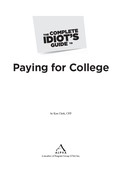The Best Accounts for Short-Term Savings
For first-time investors, the distinction between an account and an investment can be a little confusing. In basic terms, most of the investments previously mentioned in this chapter (CDs, bonds, and so on) can be owned in a variety of types of accounts, similar to how the same type of flower might be planted in a number of different pots.
Each type of account has different tax features, effects on financial aid, and withdrawal rules that need to be considered. Generally, if you’ve already filed your financial aid paperwork and you have less than 6 to 12 months until you are going to use the money, it’s best just to own the assets in your own name and open a plain-old vanilla account. If they’re for your child, it probably is not worth the hassle to try to create a special account just to avoid $10 to $20 in taxes.
However, if you have longer than 6 to 12 months; have not filed your FAFSA or CSS Profile yet; and have (or will have) significantly more than $1,000 by the time you start tapping it, you should consider some of these other account options.
Section 529 Accounts
In addition to using the Section 529 accounts discussed in Chapters 4 and 11 to purchase prepaid tuition, you can use them as a savings account. Depending on the state, they might or might not offer a fixed interest option or money market account that might fit your needs. The biggest advantage of Section 529 accounts, however, is that the earnings can be withdrawn tax-free when they’re used for qualified college expenses. They might also qualify for a state income tax deduction, depending on your state’s laws.
From a financial aid point of view, Section 529 plans owned by parents are treated as assets of the parents, meaning that 5.64 percent of the assets are expected to be used annually to fund college. This affects financial aid awards far less than accounts where the money is considered an asset of the child, which is expected to be used at a rate of 20 percent per year.
See Appendix F for a list of Section 529 plans organized by state.
Coverdell Educational Savings Accounts
Likewise, the Coverdell Educational Savings Accounts (ESAs) discussed in Chapters 4 and 11 function similarly to Section 529 plans, in that the assets can be withdrawn tax-free when they’re used to pay for college and are considered a parental asset for financial aid purposes (5.64 percent versus 20 percent required usage). However, Coverdell ESAs do not offer a state income tax deduction and cannot be opened for someone over 18. Further, any unused money in the account must be distributed to the child by the time he reaches age 30, unless you have a family member under 30 to which the account can be rolled over.
In short, these accounts don’t make sense for most people compared to a Section 529 plan. The one exception is that the money in Coverdell ESAs can be used for K-12 tuition at a private school as well. So if there is a chance that you won’t use the money for college and might need it for private school tuition, this account might make sense.
Custodial Accounts
These were the original college savings account decades ago and have generally been replaced by Section 529 plans and Coverdell ESAs. These accounts essentially allow a parent to make a gift of cash or securities to a child, whose income and gains are taxed at a much lower rate than the parent’s.
The problem is that these accounts are considered an asset of the child and count far more against financial aid than Section 529 plans, Coverdell ESAs, and savings accounts held just in a parent’s name. The only time custodial accounts make sense is if a parent has stocks or mutual funds with built-in gains that she needs to sell to pay for college. If this is the case, you should pay a visit to your tax advisor to get expert guidance on transferring these to a custodial account and then selling them.
The Least You Need to Know
• Before you stress about financial aid and scholarships, take a hard look at your budget and see how much you can free up for the next few years.
• A little bit of creative extra income will go a long way toward knocking down your tall college bills.
• Don’t get lured into risky short-term investments, even if they promise a much higher return.
• A high-yield, FDIC-insured money market or savings account might be the best option for parents with less than 12 months until college.
• Prepaid tuition plans can be the best savings option for parents with more than 12 months until college.
..................Content has been hidden....................
You can't read the all page of ebook, please click here login for view all page.
